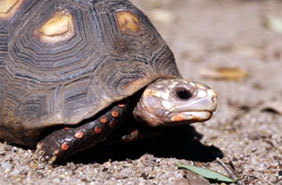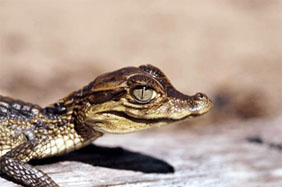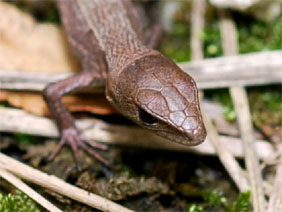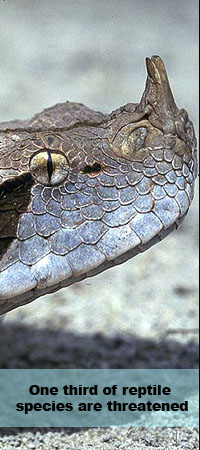|
Reptiles are important components of the food webs in most ecosystems. They fill a critical role both as predator and prey species. Herbivorous species can also be important seed dispersers, particularly on island habitats. They are also known to act as pollinators, and the blue-tailed day gecko (Phelsuma cepediana) is now the only pollinator for the rare plant Trochetia blackburniana on the island of Mauritius, since the disappearance of the plant’s key-pollinator, the olive white-eye.
Removal of any species from its ecosystem can drastically alter the populations of other organisms, but those that have a particularly influential role within an ecosystem are known as keystone species. Top predators, such as the crocodile, are often keystone species, though they also contribute to the food chain as prey whilst they are still young. Some species are considered critical for the way they modify their habitat. American alligators (Alligator mississippiensis) living in the everglades dig “gator holes”, which are often the only aquatic habitat left during the dry season, providing important refuge for many species of fish, turtle and other aquatic species, as well as a source of water for birds, terrestrial animals and plants.
Reptile species can also have a useful anthropogenic role in ecosystems. In some areas, they help control the numbers of serious agricultural pests by consuming rodent and insect pests.
Reptiles and humans
Reptiles have been hunted and traded by humans throughout history, particularly as food. Still today, reptiles can provide an important protein source for many people, or may be sold as a luxury food. Some reptiles are even used in traditional medicines. The skin of crocodiles and snakes are used in the creation of shoes, handbags and belts, and tortoiseshell has become a popular material for jewellery and decoration. Reptiles also make popular pets, with about 3% of households in USA having at least one pet reptile.
Many people are afraid of certain reptiles, such as snakes and crocodilians, and as such certain species have been persecuted by humans.
Reptiles have been popularly used in symbology and myth. Worldwide, snakes have been used as a symbol of power and sometimes evil, though they are also used in symbols for medicine. Turtles on the other hand usually represent longevity and stability, and are also often associated with creation stories.
Continue on page 4
|
|

Tuatara Sphenodon punctatus feeds heavily on weta.
© Paddy Ryan

The South American yellow-footed tortoise Geochelone denticulata is hunted for its flesh. © Pierre Fidenci

American crocodile juvenile Crocodylus acutus from Colombia occupies both freshwater and brackish lakes, coastal lagoons and mangrove swamps. © Pierre Fidenci

Reptiles fill a critical role both as predator and prey species. © Pierre Fidenci
|









